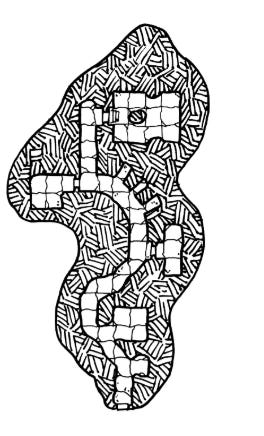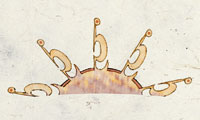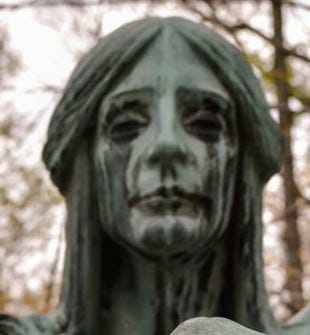Using Tombs to Teach History
In my campaigns, every delve is a school day
When I’m running a dungeon crawl, I like to use dungeon tombs to teach the history of my setting to the players. By that I don’t mean I have a history book in every dungeon - or do I? Let me explain a bit about my process.
When I’m designing a tomb, barrow, crypt or other burial site, I write up half a dozen short paragraphs in my notes describing the person or creature interred there.
I’ll cover topics such as what they looked like, how they died, great deeds they performed, crimes they committed, important relationships, significant family, places they visited and historical events they were involved in. If they were related to an existing or historic faction in my setting, that gets noted too. By the end of the process, I’ll have a block of notes like this:
Aliisza Dlardrageth
Aliisza was a scion of the cursed house of Dlardrageth and fought against her elven kin during the Seven Citadels’ War (over 5000 years ago) . She and a cabal of other elven diabolists were responsible for the fall of the the citadel on Ascal’s Horn, now known as the infamous Hellgate Keep. They opened a gate to a layer of the Abyss, calling forth hordes of demons.
During the war, the Cabal of the Black Phoenix used the souls of the slain to ascend to demon-hood, becoming Cambions imbued with the dark power of the Abyss. Aliisza became a Cambion, appearing as a cruel elven woman with blood-red skin, black horns and leathery bat wings.
Aliisza used her power to raze the elven settlement of Kerymnaar with hellfire and was infamous for being responsible for the atrocity alongside other infamous Dlardrageth such as The Bitter Prince and Countess Sarya. She become known as the ‘Scourge of Kerymnaar’.
A Cambion’s native plane is the Abyss, slaying them merely banishes them. Knowing this, the elves of Eaerlann finally brought Aliisza to justice when the paladin Kal Voren of the Watch Eternal subdued her and a circle of archmages of Arcorcar bound her as a statue of living stone. Rendering Aliisza unable to return to the Abyss and immobile but aware as a statue, the Watch Eternal interred her in a tomb, placing her behind traps and wards that her stone prison would remain eternal.
This is my resource and inspiration for designing the dungeon. Some of it was fleshed out by background in the Forgotten Realms setting where my game is set (Hellgate Keep, House Dlardrageth), but much is altered or made up to suit my campaign. It will inform both what I dress the dungeon with and the design and purpose of the tomb defenses. I went and grabbed a dungeon from Dyson Logos for the layout and went to work.
So what did this mean, practically? I want to use the dungeon to tell this story to my players, let them learn about the Seven Citadels War, it’s participants and why there are so many ruins and tombs related to it scattered through the High Forest (the site of Eaerlann and Hellgate Keep).
Firstly I looked at the external description of the tomb. In this instance, the Watch Eternal didn’t want anyone freeing their petrified prisoner. She was to be kept as a living statue as punishment and also so she wouldn’t simply return to plague future generations if she was banished to the Abyss. This means the entrance of the dungeon needs warnings!
I jotted down the entrance as a keyed part of my dungeon notes with the following description:
1: ENTRANCE
Sickly weeds, black vines and disturbing dark red blooms grow around a forboding capstone adorned with a sinister skull. Ancient skeletons of small animals litter the floor, contorted in pained shapes and choked with weeds..
The blooms are Tombvines that grow and feed in unholy places: (Nature)
Faded runes of an expired Arcane Lock and Glyph of Warding are on the Capstone: (Arcana)
Weathering indicates runes will have been defunct for hundreds of years: (Investigation)
Wizard Signature rune was once used by the archmages of Arcorar: (History)
Arcorar was an ancient Elven kingdom that fought in an elven civil war: (History)
Extremely archaic elven script reads “Death awaits beyond this threshold.” (Elvish, History required to understand anything more than the word Death)
You’ll note I don’t record DC’s for the skill checks. If the player has the skill, I give them the information unless there is some sort of risk or challenge involved. I got sick of information being locked behind poor dice rolls. I run a LOT of 5e but as I run more games, the OSR view of treating characters as experts in what they do and only rolling when there’s a failure involving risk appeals to me.
The door to the dungeon tells the players a few things - there’s something bad in here, the people that put it there didn’t want anyone going in and it was built a long time ago and warded by elven archmages of that time. Anything else, rolls for breaking open the tomb, checks for traps, etc, I’ll improvise in the moment. I’ve run enough games that I can handle players breaking open a big stone door on the fly.
Now on to the good stuff, what’s inside? The builders of Aliisza Dlardrageth’s prison want to deter would-be tomb robbers. I decided they would approach this in two ways: warnings and if that didn’t work, traps.
2: TRAPPED CORRIDOR
Dust lies heavily on the floor. Faded murals of elves and demons in battle cover the walls.
One mural depicts a sinister castle on a mountain peak, hordes of demonic figures pouring forth. (History will identify Hellgate Keep).
Another shows an unholy sacrifice before a two-headed monstrous demon lord (Religion identifies Demogorgon) and a circle of elven mages transforming into hateful winged demons (Religion identifies Cambions). Their clothes and adornments bear the symbol of a bat winged phoenix. (Arcana identifies a the Cabal of the Black Phoenix, an elven order of diabolists)
The wall opposite the first door has a particularly lurid mural of a red-skinned female elf with bat wings calling down fire and lightning to slay her enemies. Below her, an elven palace burns. (Arcana identifies high level spells like meteor swarm. The elven palace has
Runes below the mural in archaic elven script read “Aliisza Dlardrageth, Kinslayer and Scourge of Kerymnaar” (elvish, need history to translate any more than the names and the words kin and death)
I added a few notes about a deadfall trap and a gas trap. I decided the gas caused hallucinations, making the murals seem to come alive and reenact the scenes they depict. I jotted down save DCs, DC’s to spot the traps when searching and damage. I noted the triggers (a pressure plate and a metal tripwire).
Then I added some old artifacts from the Seven Citadel’s war as treasure and items of interest: some in niches along the walls, others in trapped chests holding ancient artifacts and trophies - banners of house Dlardrageth with their crest, jewelry and elven armour deemed tainted by the touch of the Abyss and interred here in a vault behind the first locked door, deciding to dub it the Battle Vault.
The history portrayed here lets my players learn about the cabal of diabolists and of Aliisza Dlardrageth as well as locations of note such as Hellgate keep or Kerymnaar. The campaign I’m running is a hexcrawl and I’ll let players use Survival when navigating to try and work out the directions of these locations based on landmarks seen in the murals.
3: THE BATTLE VAULT
Faded frescos depicting many harrowing battle scenes cover the walls here. In all of them, a bat winged elf is depicting annihilating her foes with lightning and fire, surrounded by demonic monstrosities such as four-armed Glabrezu demons and fire-wielding Balor. A particularly lurid fresco depicts Aliisza being humbled in combat with a half-elf Paladin bearing a sword of light. Many of the spells and weapons are picked out in gilt and glittering gem fragments. An inscription names the hero Kal Voren and that he wields the blade Heaven’s Fury (History tells the players that they have heard of an old crypt in the High Forest that contains a reliquary of Kal Voren’s bones and armour, a site of pilgrimage for holy warriors, Religion identifies Heaven’s Fury as a Holy Avenger, forged by angels of Law and Justice).
I decided that PCs spending an hour carefully removing the fragments gather gem shards and gilt worth 250 gp.
I grabbed an image of the Dlardrageth crest to show to the players. Hidden amongst the items and not noticed by the Watch Eternal when they sealed away the Dlardrageth artifacts was a map. This let me seed a few more locations related to this history I was depicting to the players. It gave them the location of the tomb of Azad Gilaru, the Bitter Prince (more about him later), a Dlardrageth armory cache and the ruins of Kerymnaar. My players now know about a climactic battle, an ancient hero, a ruin they can explore and leads on powerful good and evil items.
Next, I fleshed out the penultimate room and called it the Binding Vault
4: THE BINDING VAULT
More frescos in this chamber depict the final fate of Aliisza at the hands of elven archmages of Arcora - a winged demonic figure surrounded by robed elven spellcasters soundlessly screaming as she is turned to stone. Walls of light surround the corrupt fortress of Hellgate Keep (History - Hellgate Keep is a forbidden place surrounded by ancient magic wards, now tended and renewed by the druids of the High Forest) and other Dlardrageth are depicted being herded into an enormous stone doorway surrounded by arcane runes (Arcana - they look like abjurations used to bind demons in a magic circle) and a strange image above the lintel (Religion and Elf to know that this is the symbol of Labelas Enoreth, Elven god of Time and Fate).
Archaic elven runes read “The Scourge is bound.”
There are more valuables and gem fragments here for the players to sift through. I make sure any items are creepy, with malevolent runes and made of morbid substances like bone, fangs, black iron and obsidian. This seeds a few things with my players. They learn that the majority of the Dlardrageth were imprisoned somehow. They know the prison has an arcane element of imprisonment and a religious element involving time. It just so happens the Nameless Dungeon (north in my hexcrawl) is the stasis prison holding other Cambions and keeping them from returning from the abyss if they were slain. Finally, they know of Aliisza Dlardrageth’s final fate which means I can flesh out the final room with an obvious piece of dungeon dressing.
5: CHAMBER OF LIVING STONE
The entrance to this room is peculiar, with a row of shallow indentations in the stone floor of the threshold. However, of more note is a low, rough-hewn stone sarcophagus stands in the centre of this chamber. Behind the sarcophagus, on a marble plinth, stands the statue of a female elf with curving horns, bat-like wings and clad in form-hugging robes. Her eyes are living and aware, weeping black oily tears as they stare pleadingly at you, gazing out of a stone face contorted in a scream. The floor of the chamber is littered with broken stones and shattered pieces of statue. The walls are adorned with arcane runes that pulse with a baleful, violet light.
Creepy, right? A cool reveal in the final room. I decided that to get to this, there would be a sealed door with dire warnings inscribed on it “Beyond this door, hope is smashed and dreams are shattered.” in archaic elvish and I added explosive runes (thunder).
I decided to put a denizen in this room: The Skeleton Tomb Guardian (a construction left here by the archmages) emerges from its sarcophagus and attacks three rounds after intruders unseal the door. It chases intruders, but does not leave the tomb. It will aggressively smash any petrified intruders if it cannot engage any that are still moving and then retrun to its sarcophagus. What do I mean by petrified?
Well, the round after the guardian emerges, I decided that a portcullis slams down in the doorway and petrification gas spills out of the sarcophagus to flood the room. Anyone inhaling the gas must pass a DC 14 Constitution save or turn to stone. The portcullis will retract and the gas will dissipate after 10 minutes.
Essentially, this trap is themed after Aliisza’s fate. I decided to telegraph this with the smashed remains of a petrified intruder that had bypassed the entrance with a gaseous form potion.
Having made my notes about the trap and having sourced a suitable statblock for the guardian, I finished out my prep with a few other descriptions of area features and loot:
Sarcophagus with a rough finish—as if the stonemason didn’t finish the job. The lid is heavy and sturdy enough not to shatter if pushed off onto the floor. The Tomb Guardian will push the lid off if it attacks.
Sarcophagus (Internal): An ancient vent in the base of the sarcophagus slowly leaks petrification gas, though this will only build up to dangerous levels if the stone lid is in place.
Statue: The Statue of Allisza Dlardageth radiates transmutation magic, evil and the unholy aura of the Abyss. The half demon sorceress may be freed with a Greater Restoration spell. Smashing the statue will alow the half demon to re-form in the Abyss but she will be banished from the prime material plane for 666 days. In either event, she will begin gathering demonic allies to free her kin from their prisons in the forest. She is aware of her surroundings and will remember the actions of any who enter here.
Disarm: The portcullis can be blocked by a dagger or spike wedged into a crevice in the wall.
Dusty Floor: Scuffed tracks are evident in the thick dust. Smashed pieces of a petrified intruder litters the floor (describe as smashed statue)
Treasure: I rolled up a few items and valuables that belonged to the petrified tomb robber and added a potion of gaseous form with a remaining dose or two - this would explain how they had penetrated this far without triggering other traps and glyphs.
So, there you have it, a dungeon that's shaped and teaches the history of my setting.
It's loosely inspired by Mike Shea's Lazy Dungeon Master approach to Secrets & Clues, but also helps me shape the dungeon dressing so that each dungeon has its own character and reveals a bit more of the background and history of the setting, giving my world depth and a lived in feel.
I'm currently teaching my players the history of Azad, the Bitter Prince, his fall from grace and eventual curse of undeath. His particular tomb reflects that journey.
The crypt is a somber elven mausoleum on the surface, hiding corruption in the lower levels. The decoration has changed from serene depictions of the Seldarine to murals showing Azad's fall and his pledge to infernal powers. In next weeks session they'll learn his fate and face what he has become.
Hopefully they'll have as much fun learning this history as I've had coming up with it and I hope other DMs find this overview of my process useful. Let me know!





